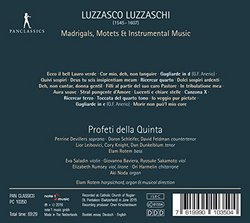| All Artists: Profeti della Quinta Title: Luzzaschi: Madrigal, Motets & Instrumental Music Members Wishing: 0 Total Copies: 0 Label: Naxos of America, Inc. Release Date: 1/29/2016 Genres: Pop, Classical Styles: Easy Listening, Chamber Music Number of Discs: 1 SwapaCD Credits: 1 |
Search - Profeti della Quinta :: Luzzaschi: Madrigal, Motets & Instrumental Music
 | Profeti della Quinta Luzzaschi: Madrigal, Motets & Instrumental Music Genres: Pop, Classical In his publications, Luzzasco Luzzaschi (c. 1545-1607) presents himself, rather modestly as the Organist of the Serene Highness Duke of Ferrara. Accordingly, Luzzaschis reputation today is similarly modest; he is known, if... more » |
Larger Image |
CD Details
Synopsis
Product Description
In his publications, Luzzasco Luzzaschi (c. 1545-1607) presents himself, rather modestly as the Organist of the Serene Highness Duke of Ferrara. Accordingly, Luzzaschis reputation today is similarly modest; he is known, if at all, thanks only to the music he composed for the Concerto delle Dame an ensemble of virtuoso female singers at the dEste court in Ferrara. And yet, when his entire oeuvre is explored, one discovers that his music and influence are greater than could have been imagined. In fact, Luzzaschi was both musically and historically one of the central musical figures of the late Renaissance. This recording presents a broad picture of Luzzaschis oeuvre, selecting works in various genres, performed in historically informed settings with appropriate performance practices. While pieces for the Concerto delle Dame are included, one of the intentions of Profeti della Quinta is to highlight the fact that the rest of Luzzaschis output stands equally alongside these compositions. Many of the pieces are recorded here for the very first time. The programme opens with a festive six-voice madrigal (Ecco il bel Lauro verde) performed with singers and an instrumental consort. This is followed by madrigals for five voices, performed either a cappella or with chitarrone accompaniment; grave polyphonic motets performed with organ accompaniment, and various instrumental pieces. The picture is completed by pieces written for the Concerto delle Dame as well as special new arrangements of five-voice madrigals into solos and duets, which evidence suggests was done at the time of the Concerto delle Dame.
